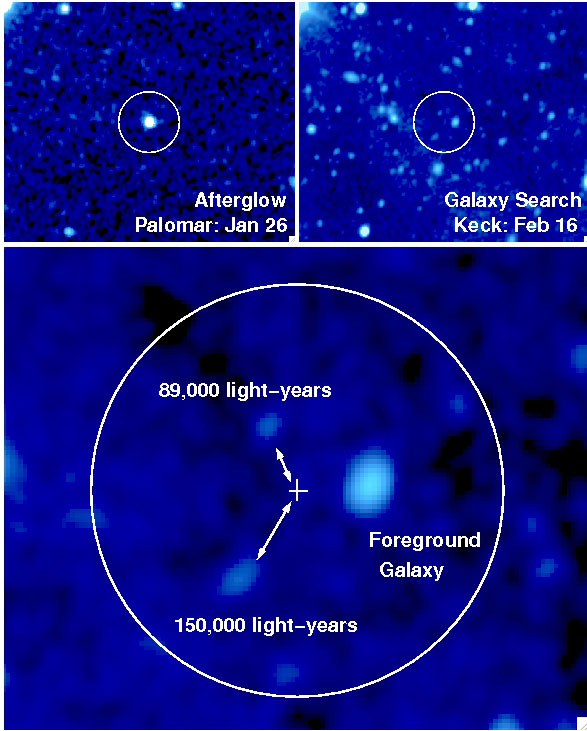
 Credit: B. Cenko, et al. and the W. M. Keck Observatory
Credit: B. Cenko, et al. and the W. M. Keck Observatory
Homeless
Out of the dark night, a bright flash of gamma-rays explodes, then recedes into darkness. A flash brighter than a billion stars. What could it be? Astronomers look quick to find the answer, training small fast telescopes, then more powerful telescopes at the fading explosion, hoping to get a glimpse of the explosion and a view of its environs. Astonishingly, astronomers have managed to identify hosts for over a hundred gamma-ray bursts, and what they've found has helped solve the mystery of these events: they seem to take place within star forming galaxies and suggest that these explosions are associated with the death of a massive star. But a new burst has got astronomers very puzzled. This burst was first detected by the fleet of the Interplanetary Network, then by the Swift observatory. The afterglow of the giant explosion (shown above, top left) was then imaged by the Palomar 60-inch robotic telescope. None of these observatories were able to find the faint galaxy hosting this explosion. So astronomers trained one of the largest telescopes on earth, the 10-meter Keck telescope, on the area of the burst; but, astonishingly, as shown top left, and in the zoomed-in image at the bottom, nothing showed up. No galaxy, no host. Maybe this is a rare star which was born between galaxies, or got ejected from its host galaxy? No one knows for sure.
<
HEA Dictionary ● Archive
● Search HEAPOW
● Other Languages
● HEAPOW on Facebook
● Download all Images
● Education ● HEAD
>
Each week the HEASARC
brings you new, exciting and beautiful images from X-ray and Gamma ray
astronomy. Check back each week and be sure to check out the HEAPOW archive!
Page Author: Dr. Michael F. Corcoran
Last modified Tuesday, 27-Feb-2024 10:15:19 EST


